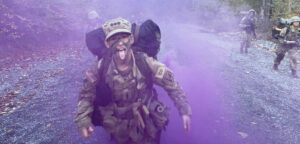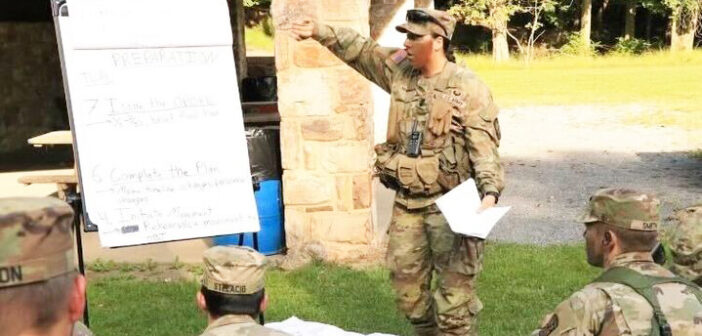For over 100 years, the Steel Battalion at Lehigh has helped train future officers of the U.S. Army.
In Sept. 1919, when the Reserve Officers Training Corps (ROTC) was created, Lehigh was one of the first three schools in the country to establish an infantry unit. In 1925, an ordnance unit was added, and in 1947 the Corps of Engineers was added as well.
In 1958, Jordan Hall — an original Bethlehem Steel building — was turned into the home of the ROTC department. On Mountaintop Campus, the Steel Battalion Cadets have over 20 acres of wooded forest with a ropes course, squad situational training lanes and a land navigation course.
Today, the Steel Battalion boasts 75 cadets hailing from 11 local universities. About 40 of the cadets are from Lehigh and approximately 30% of them are women — according to JaJuan Broussard, the Steel Battalion’s recruiting operations officer.
Lehigh did not admit any female students until the class of 1975, and ROTC did not allow women into their programs until about a year later.
Broussard said there has been an increase in the number of female cadets in the years that he has been there.
To recruit cadets, Broussard uses the SAL model: Scholar, Athlete and Leader.
“We’re looking for the prospects who have 3.5 and above GPAs. Athletes, whether it be one, two, three sports or intramural sports, or even gamers; someone who values teamwork,” Broussard said. “We look at leadership, if you are the president of an organization, or if you serve on the e-board, if you do community service, volunteer hours, part time, full time jobs, anything like that. We’re looking for that potential prospect to have that SAL model.”
Cadet Irene Macri, command sergeant major and a senior at Lehigh, said that she was inspired to join the ROTC program at Lehigh because her older brother went through it six years prior. Before joining, she was also a cross country runner and threw shotput and discus in track and field.
“Monday through Wednesday, the only obligation is physical training in the morning from 5:45 to 7:00 a.m. because nobody has class then,” Macri said. “Thursdays are very busy, we go into army tactics and infantry tactics. Infantry tactics is how you’re ranked among other cadets in your grade and across the country, so not everyone goes into infantry. But using those rubrics, that’s how you’re graded.”
On Thursdays — from 4:30 to 7:30 p.m. — there is a three-hour lab where cadets go into South Mountain Park near Mountaintop Campus. There, the cadets split up and train in a simulated environment in the woods where there are opposing enemy forces.
In this simulated environment, a platoon of 30 people are given a mission to find the opposing forces and make sure they don’t pose any danger in the simulation.
Before the lab, the senior leaders will have several meetings with different cadres and leaders to prepare for the lab.
Macri said as a senior the leadership roles are more intense. She said despite having faculty and staff, it is a cadet-run program, so the seniors run almost everything.
“Because the Army and ROTC have a large population of males, it can be intimidating for women to join the program. But, the Steel Battalion has a zero-tolerance policy for any type of extremism; such as racism, or sexism,” Broussard said. “If any cadre hears about harassment it is immediately shut down and reported to the Title IX coordinator.”
Cadet Allison Hoff — MS Level 3 — said as a new cadet in the program doing basic training camp over the summer, it was challenging for her to come in with zero military experience. However, Hoff quickly found herself leaning on other female officers in the program for support and views them as her mentors.
“My personal experience with The Steel Battalion has been nothing short of awesome. The male cadets here are treated the exact same as a female,” Hoff said. “As long as you represent yourself with confidence and an ability to lead, they look up to that and respect you as an individual.”

First lieutenant Aubre Ibanez poses during ROTC training. Ibanez graduated form Lehigh ROTC in 2022. (Courtesy of Hannah Maggio)
Aubre Ibanez, first lieutenant and 2022 Lehigh ROTC graduate said the most important thing is to exude confidence as a cadet, especially as a female cadet.
“The military as a whole is probably 10% women, and they’re awesome,” Ibanez said. “I love my ‘girly pops’ and I work in a specialized division that is maybe 5% female, so my experience might be a little different. I’m around men a lot more, but they’re good guys.”
During training, cadets may have to throw a 10 lb ball 12 meters. Ibanez said that there was no way she would be able to do that, so she would often ask one of the male cadets to help her. In return, she would help write up their reports. The cadets would work together to complete their tasks efficiently and use their strengths to contribute to the battalion.
If a student is interested in joining the Steel Battalion, ROTC classes with the Steel Battalion are available to all students to audit. Students are welcome to attend the leadership labs every Thursday evening as well. Physical Training is available from 5:45 to 7:00 a.m. Monday through Wednesday to all students after signing a waiver.
For more information about ROTC, you can reach out to JaJuan Broussard, at jabe21@lehigh.edu.





Comment policy
Comments posted to The Brown and White website are reviewed by a moderator before being approved. Incendiary speech or harassing language, including comments targeted at individuals, may be deemed unacceptable and not published. Spam and other soliciting will also be declined.
The Brown and White also reserves the right to not publish entirely anonymous comments.
2 Comments
This doesn’t seem to describe the Army ROTC experience from 1964 to 1968.
In 1971 there was AF ROTC and there were two women in that class. Ann Schmoyer Story graduated as a first lieutenant and had a military career. I was the other woman who left in 1973 at junior year commitment time.